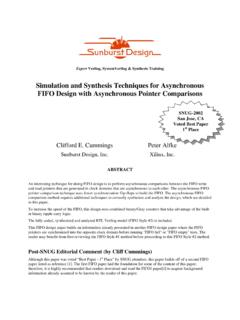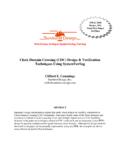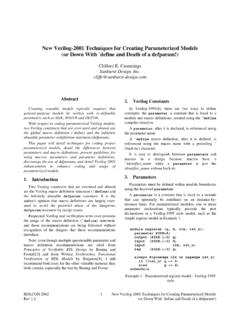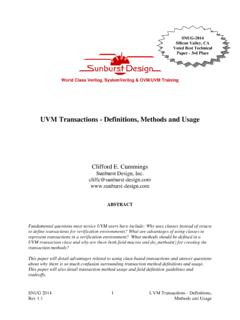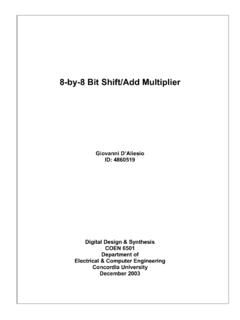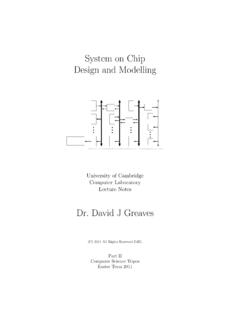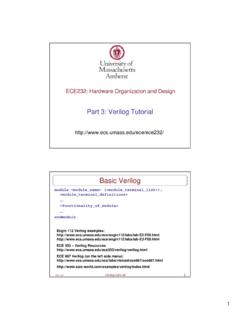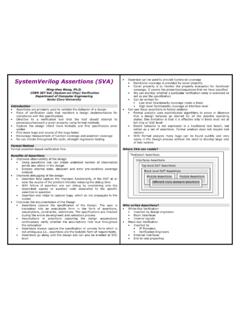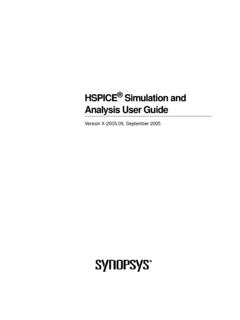Transcription of Asynchronous & Synchronous Reset Design Techniques - …
1 Asynchronous & Synchronous ResetDesign Techniques - Part DeuxClifford E. CummingsDon MillsSteve GolsonSunburst Design , EngineeringTrilobyte paper will investigate the pros and cons of Synchronous and Asynchronous resets. It willthen look at usage of each type of Reset followed by recommendations for proper usage of Boston 2003 Asynchronous & Synchronous ResetRev Techniques - Part IntroductionThe topic of Reset Design is surprisingly complex and poorly emphasized. Engineering schoolsgenerally do an inadequate job of detailing the pitfalls of improper Reset Design . Based on ourindustry and consulting experience, we have compiled our current understanding of issuesrelated to Reset - Design and for this paper have added the expertise of our colleague Steve Golson,who has done some very innovative Reset Design work. We continually solicit and welcome anyfeedback from colleagues related to this important Design presented our first paper on Reset issues and Techniques at the March 2002 SNUG conference[4] and have subsequently received numerous email responses and questions relatedto Reset Design obviously did not adequately explain all of the issues related to the Asynchronous resetsynchronizer circuit because many of the emails we have received have asked if there aremetastability problems related to the described circuit.
2 The answer to this question is, no, thereare no metastability issues related to this circuit and the technical analysis and explanation arenow detailed in section of this to use Synchronous or Asynchronous resets in a Design has almost become a religiousissue with strong proponents claiming that their Reset Design technique is the only way toproperly approach the our first paper, Don and Cliff favored and recommended the use of Asynchronous resets indesigns and outlined our reasons for choosing this technique . With the help of our colleague,Steve Golson, we have done additional analysis on the subject and are now more neutral on theproper choice of Reset , there are distinct advantages and disadvantages to using either Synchronous orasynchronous resets, and either method can be effectively used in actual designs. When choosinga Reset style, it is very important to consider the issues related to the chosen style in order tomake an informed Design paper presents updated Techniques and considerations related to both Synchronous andasynchronous Reset Design .
3 This version of the paper includes updated Verilog-2001 ANSI-styleports in all of the Verilog first version of this paper included an interesting technique for synchronizing the resetting ofmultiple ASICs of a high speed Design application. That material has been deleted from thispaper and readers are encouraged to read the first version of the paper if this subject is Boston 2003 Asynchronous & Synchronous ResetRev Techniques - Part Resets PurposeWhy be concerned with these annoying little resets anyway? Why devote a whole paper to sucha trivial subject? Anyone who has used a PC with a certain OS loaded knows that the hardwarereset comes in quite handy. It will put the computer back to a known working state (at leasttemporarily) by applying a system Reset to each of the chips in the system that have or require individual ASICs, the primary purpose of a Reset is to force the ASIC Design (eitherbehavioral, RTL, or structural) into a known state for simulation.
4 Once the ASIC is built, theneed for the ASIC to have Reset applied is determined by the system, the application of the ASIC,and the Design of the ASIC. For instance, many data path communication ASICs are designed tosynchronize to an input data stream, process the data, and then output it. If sync is ever lost, theASIC goes through a routine to re-acquire sync. If this type of ASIC is designed correctly, suchthat all unused states point to the start acquiring sync state, it can function properly in a systemwithout ever being Reset . A system Reset would be required on power up for such an ASIC if thestate machines in the ASIC took advantage of don t care logic reduction during the believe that, in general, every flip-flop in an ASIC should be resetable whether or not it isrequired by the system. In some cases, when pipelined flip-flops (shift register flip-flops) areused in high speed applications, Reset might be eliminated from some flip-flops to achieve higherperformance designs.
5 This type of environment requires a predetermined number of clocksduring the Reset active period to put the ASIC into a known Design issues must be considered before choosing a Reset strategy for an ASIC Design ,such as whether to use Synchronous or Asynchronous resets, will every flip-flop receive a Reset ,how will the Reset tree be laid out and buffered, how to verify timing of the Reset tree, how tofunctionally test the Reset with test scan vectors, and how to apply the Reset across multipleclocked logic General flip-flop coding style Synchronous Reset flip-flops with non Reset follower flip-flopsEach Verilog procedural block or vhdl process should model only one type of flip-flop. Inother words, a designer should not mix resetable flip-flops with follower flip-flops (flops with noresets) in the same procedural block or process[14]. Follower flip-flops are flip-flops that aresimple data shift the Verilog code of Example 1a and the vhdl code of Example 1b, a flip-flop is used tocapture data and then its output is passed through a follower flip-flop.
6 The first stage of thisdesign is Reset with a Synchronous Reset . The second stage is a follower flip-flop and is not Reset ,but because the two flip-flops were inferred in the same procedural block/process, the resetsignal rst_n will be used as a data enable for the second flop. This coding style will generateextraneous logic as shown in Figure Boston 2003 Asynchronous & Synchronous ResetRev Techniques - Part Deux4module badFFstyle ( output reg q2, input d, clk, rst_n); reg q1; always @(posedge clk) if (!rst_n) q1 <= 1'b0; else begin q1 <= d; q2 <= q1; endendmoduleExample 1a - Bad Verilog coding style to model dissimilar flip-flopslibrary ieee;use ;entity badFFstyle is port ( clk : in std_logic; rst_n : in std_logic; d : in std_logic; q2 : out std_logic);end badFFstyle;architecture rtl of badFFstyle is signal q1 : std_logic;begin process (clk) begin if (clk'event and clk = '1') then if (rst_n = '0') then q1 <= '0'; else q1 <= d; q2 <= q1; end if; end if; end process;end rtl.
7 Example 1b - Bad vhdl coding style to model dissimilar flip-flopsSNUG Boston 2003 Asynchronous & Synchronous ResetRev Techniques - Part Deux5 Figure 1 - Bad coding style yields a Design with an unnecessary loadable flip-flopThe correct way to model a follower flip-flop is with two Verilog procedural blocks as shown inExample 2a or two vhdl processes as shown in Example 2b. These coding styles will generatethe logic shown in Figure goodFFstyle ( output reg q2, input d, clk, rst_n); reg q1; always @(posedge clk) if (!rst_n) q1 <= 1'b0; else q1 <= d; always @(posedge clk) q2 <= q1;endmoduleExample 2a - Good Verilog-2001 coding style to model dissimilar flip-flopslibrary ieee;use ;entity goodFFstyle is port ( clk : in std_logic; rst_n : in std_logic; d : in std_logic; q2 : out std_logic);end goodFFstyle;architecture rtl of goodFFstyle is signal q1 : std_logic;begin process (clk) beginSNUG Boston 2003 Asynchronous & Synchronous ResetRev Techniques - Part Deux6 if (clk'event and clk = '1') then if (rst_n = '0') then q1 <= '0'; else q1 <= d; end if; end if; end process; process (clk) begin if (clk'event and clk = '1') then q2 <= q1; end if; end process;end rtl.
8 Example 2b - Good vhdl coding style to model dissimilar flip-flopsFigure 2 - Two different types of flip-flops, one with Synchronous Reset and one withoutIt should be noted that the extraneous logic generated by the code in Example 1a and Example1b is only a result of using a Synchronous Reset . If an Asynchronous Reset approach had be used,then both coding styles would synthesize to the same Design without any extra combinationallogic. The generation of different flip-flop styles is largely a function of the sensitivity lists andif-else statements that are used in the HDL code. More details about the sensitivity list andif-else coding styles are detailed in section Flip-flop inference styleEach inferred flip-flop should not be independently modeled in its own proceduralblock/process. As a matter of style, all inferred flip-flops of a given function or even groups offunctions should be described using a single procedural block/process.
9 Multiple proceduralblocks/processes should be used to model larger partitioned blocks within a givenmodule/architecture. The exception to this guideline is that of follower flip-flops as discussed insection where multiple procedural blocks/processes are required to efficiently model thefunction Boston 2003 Asynchronous & Synchronous ResetRev Techniques - Part Assignment operator guidelineIn Verilog, all assignments made inside the always block modeling an inferred flip-flop(sequential logic) should be made with nonblocking assignment operators[3]. Likewise, forVHDL, inferred flip-flops should be made using signal Synchronous resetsAs research was conducted for this paper, a collection of ESNUG and SOLV-IT articles wasgathered and reviewed. Around 80+% of the gathered articles focused on Synchronous resetissues. Many SNUG papers have been presented in which the presenter would claim somethinglike, we all know that the best way to do resets in an ASIC is to strictly use synchronousresets , or maybe, Asynchronous resets are bad and should be avoided.
10 Yet, little evidence wasoffered to justify these statements. There are both advantages and disadvantages to using eithersynchronous or Asynchronous resets. The designer must use an approach that is appropriate forthe resets are based on the premise that the Reset signal will only affect or Reset thestate of the flip-flop on the active edge of a clock. The Reset can be applied to the flip-flop aspart of the combinational logic generating the d-input to the flip-flop. If this is the case, thecoding style to model the Reset should be an if/else priority style with the Reset in the ifcondition and all other combinational logic in the else section. If this style is not strictlyobserved, two possible problems can occur. First, in some simulators, based on the logicequations, the logic can block the Reset from reaching the flip-flop. This is only a simulationissue, not a hardware issue, but remember, one of the prime objectives of a Reset is to put theASIC into a known state for simulation.





